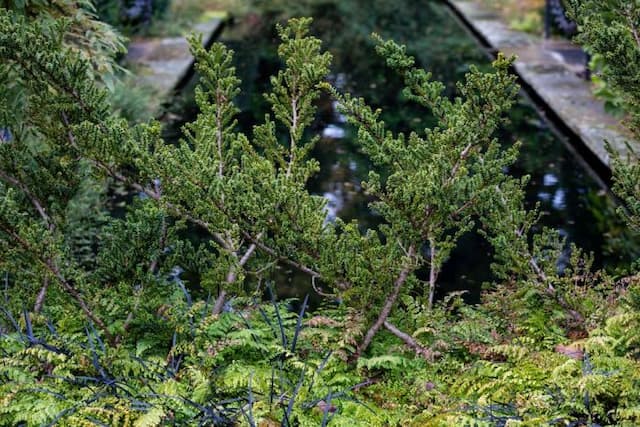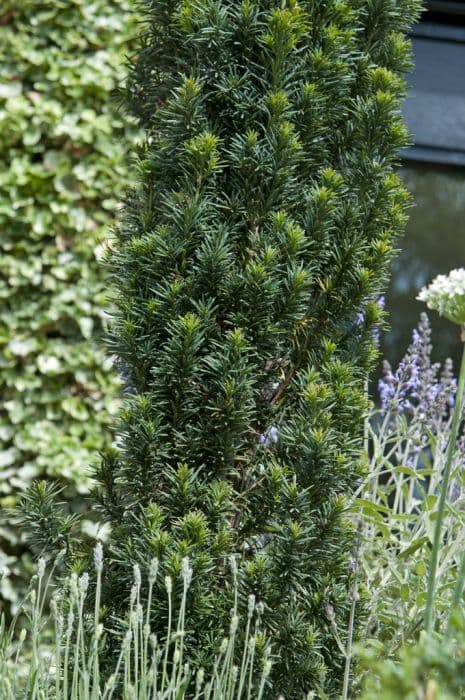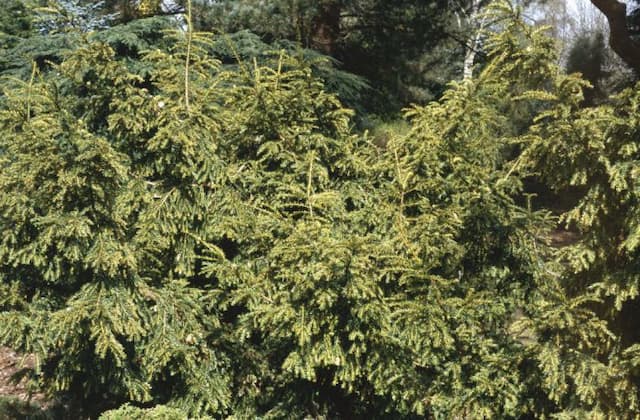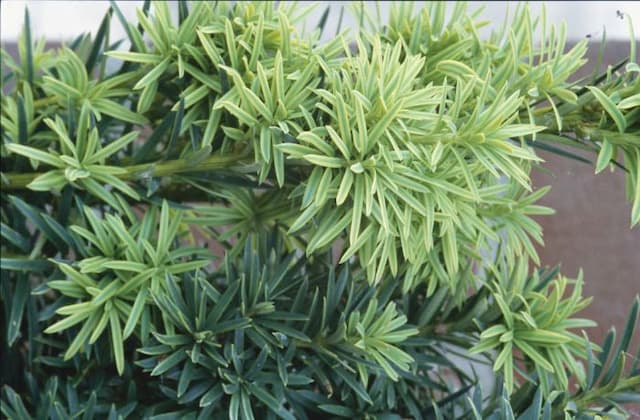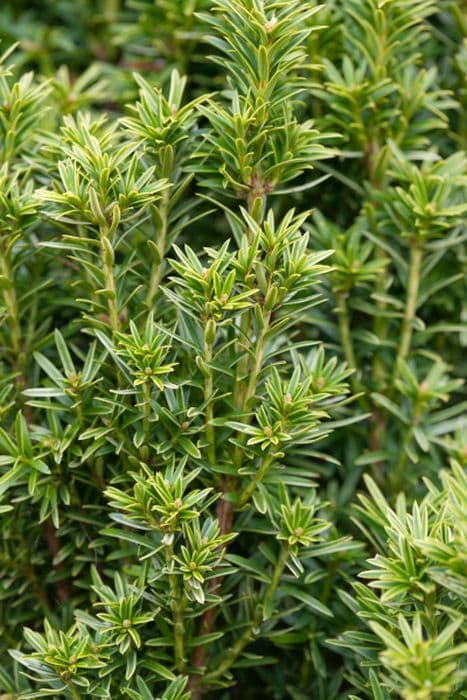Yew Taxus baccata

ABOUT
The European yew, commonly known as the yew, is a coniferous tree renowned for its rich, dark-green needles, which are arranged spirally on the branches but appear to be in two flat rows. The needles have a linear shape with a slightly curved, sharp tip, and they are soft to the touch. One of the distinctive features of the yew is its red, cup-shaped arils that encase a single seed and are open at the end. These berry-like arils are quite attractive and stand out against the green foliage. The bark of the yew is reddish-brown, with a flaky texture that peels off in small scales. As an evergreen, the yew maintains its foliage all year round, contributing to its status as a symbol of longevity and its popular use in horticulture and landscaping. Despite its beauty, the yew is toxic.
About this plant
 Names
NamesFamily
Taxaceae.
Synonyms
English Yew, European Yew, Common Yew.
Common names
Taxus baccata var. elegantissima, Taxus baccata var. fastigiata, Taxus baccata var. fructu-luteo, Taxus latifolia, Taxus recurvata.
 Characteristics
CharacteristicsLife cycle
Perennials
Foliage type
Evergreen
Color of leaves
Dark green
Height
40 65 feet (12 20 meters)
Spread
15 25 feet (4.5 7.6 meters)
Plant type
Tree
Hardiness zones
6
Native area
Europe
Benefits
 General Benefits
General Benefits- Aesthetic Appeal: Taxus baccata, commonly known as Yew, is an evergreen conifer with a dense, dark green foliage that provides year-round visual interest in landscapes.
- Habitat for Wildlife: Yew bushes offer shelter and nesting sites for various bird species, while the fleshy red arils are a food source for some birds, though the seeds within are toxic.
- Hedge Plant: Due to its dense growth and ease of pruning, yews are often used for hedges or topiary, providing privacy and structure in gardens.
- Durability: Yew is notably resilient and can tolerate a wide range of soil conditions, drought, and exposure, making it a robust option for challenging sites.
- Longevity: Yew trees are long-lived, with some specimens in Europe known to be over a thousand years old, contributing to the historical and cultural significance of a landscape.
- Architectural Use: The wood of Yew is hard and durable, making it historically valued for crafting furniture, tools, and archery bows.
- Ornamental Varieties: Yew is available in a variety of cultivars with different shapes and sizes, offering a range of ornamental options to gardeners and landscapers.
- Shade Tolerance: Yews can grow in full sun to deep shade, making them versatile for planting in various garden spots with differing light conditions.
- Soil Erosion Control: The extensive root system of Yew helps stabilize the soil and prevent erosion on slopes or in areas with loose soil.
 Medical Properties
Medical Properties- Anticancer: Taxus baccata contains compounds, particularly paclitaxel (Taxol), which is used in the treatment of various cancers including ovarian, breast, and lung cancer.
- Antimitotic Agent: Taxol from Taxus baccata acts to stabilize microtubules, which inhibits cell division, making it effective in cancer treatment.
 Air-purifying Qualities
Air-purifying QualitiesThis plant is not specifically known for air purifying qualities.
 Other Uses
Other Uses- Woodworking: The wood of Taxus baccata, commonly known as English yew, is dense and has a fine grain, making it suitable for intricate woodworking projects such as furniture-making and carving.
- Archery Bows: Historically, English yew was the preferred material for longbows in Europe due to its combination of strength and elasticity.
- Turnery: The hard and durable wood is excellent for turning on a lathe to create ornamental objects, tool handles, and other cylindrical items.
- Garden Ornaments: English yew is often shaped into topiary forms, due to its dense foliage and tolerance for heavy pruning, making it a popular choice for decorative hedge sculptures in gardens.
- Religious Symbolism: English yew trees are commonly found in churchyards throughout Britain, symbolizing eternal life and often planted for their longevity and evergreen nature.
- Dye Production: The bark and needles of the English yew can be used to produce natural dyes for textiles, yielding various shades of brown and green.
- Protective Ground Cover: Due to its ability to spread and create dense foliage, English yew can be used to prevent soil erosion in sloped areas and shady landscapes.
- Sound Insulation: The dense wood of the English yew can serve as an effective sound barrier when used in hedges or as part of a wall structure, reducing noise pollution.
- Folklore and Tradition: English yew branches and foliage have been used in various cultural traditions and folklore rituals, such as during winter solstice celebrations.
- Cemetery Plantings: English yew trees are commonly planted in cemeteries, not only for their longevity and evergreen nature but also because their roots are said to help stabilize the graveyard soil.
Interesting Facts
 Feng Shui
Feng ShuiThe English Yew is not used in Feng Shui practice.
 Zodiac Sign Compitability
Zodiac Sign CompitabilityThe English Yew is not used in astrology practice.
 Plant Symbolism
Plant Symbolism- Eternity: The yew tree (Taxus baccata) is often connected with eternity because it is one of the longest-lived plants in Europe, with some specimens surviving for thousands of years.
- Death and Resurrection: In many cultures, the yew tree is seen as a symbol of death due to its toxicity and dark, somber appearance, but it is also associated with resurrection because it stays green year-round, signifying immortality and the continual cycle of life.
- Protection: Its evergreen nature and the durability of its wood also make the yew symbolic of protection, often planted in churchyards and cemeteries to guard the spirits of the dead.
- Transformation: The yew is linked with transformation and alchemy, with its ability to regenerate by sending down new shoots from its branches to the ground, signifying nature's power of renewal and change.
- Sacredness: In ancient times, the Celts and other indigenous peoples held the yew as sacred, using it in rituals and as a doorway to understand the mysteries of life and death.
 Water
WaterThe English Yew (Taxus baccata) should be watered regularly, but allow the soil to dry out slightly between watering sessions. For outdoor plants, watering once a week with about 1 to 2 gallons of water is usually sufficient during dry conditions. During the growing season, in the absence of rainfall, increase watering to twice a week. Over the winter, reduce watering as the plant's growth slows down and the plant requires less moisture. Ensure that the English Yew is planted in well-drained soil to prevent waterlogging, which can lead to root rot.
 Light
LightEnglish Yew prefers partial to full shade and should be sheltered from intense midday sun. It thrives in a spot that receives filtered sunlight or morning sun followed by afternoon shade. Although adaptable, this plant is best suited for locations where natural light is dappled, such as under the canopy of larger trees, to protect it from scorching.
 Temperature
TemperatureEnglish Yew is hardy and can withstand a wide temperature range, from as low as 0°F to about 90°F, but it thrives best in temperate climates. The ideal temperature range for this species is between 60°F and 70°F. It is tolerant of cold and can survive short periods of more extreme temperatures, as long as the planting site provides adequate shelter and the plant is well-maintained.
 Pruning
PruningPruning the English Yew is important to maintain its shape and remove any damaged or diseased branches. Prune in late winter or early spring before new growth starts. Light pruning can be done again in mid-summer if necessary to shape the plant or control its size. The best time for major pruning, however, is when the plant is dormant.
 Cleaning
CleaningAs needed
 Soil
SoilEnglish Yew (Taxus baccata) thrives best in well-draining, loamy soil with a pH range of 6.0 to 7.5. A good mix would be one part garden soil, one part peat, and one part sand or perlite. This combination ensures proper drainage while retaining enough moisture.
 Repotting
RepottingEnglish Yew (Taxus baccata) is a slow-growing plant and generally needs to be repotted every 3-5 years. It's best to repot in the spring, just before the growing season begins.
 Humidity & Misting
Humidity & MistingEnglish Yew (Taxus baccata) prefers moderate humidity levels but is quite adaptable to different humidity conditions. It can usually cope with the humidity found in most outdoor environments naturally.
 Suitable locations
Suitable locationsIndoor
Place English Yew in bright, indirect light and avoid dry air.
Outdoor
Plant English Yew in partial shade; shelter from strong winds.
Hardiness zone
6-7 USDA
 Life cycle
Life cycleTaxus baccata, commonly known as yew, begins its life cycle when seeds are dispersed by animals that consume the fleshy aril surrounding the seed. Germination is often slow and can be erratic, taking several months or even years. Seedlings thrive in shady conditions and once germinated, the yew grows slowly into a small shrub. Over the years, it develops into a mature tree with a thick, reddish-brown bark and a dense canopy of evergreen, needle-like leaves. Yews are dioecious, meaning individual plants are either male or female; male trees release pollen in early spring to fertilize the ovules of female trees, which then develop into the red arils. Yews can live for hundreds of years, continually growing and producing seeds throughout their lifespan.
 Propogation
PropogationPropogation time
Late winter to early spring
Propogation: For the European Yew, also known as Taxus baccata, the most common method of propagation is by seed. Seed propagation involves stratifying the seeds for a period to overcome dormancy and then sowing them in a seedbed or containers. This process usually begins in the fall after the seeds have been harvested. The seeds must be cleaned and then mixed with sand or an equivalent medium and kept moist at about 39 degrees Fahrenheit (4 degrees Celsius), typically for two to three months. After stratification, the seeds are sown in a well-drained soil mix under controlled conditions, often in a greenhouse or cold frame. Germination can be slow and uneven, but once the seedlings emerge, they are grown on until they reach a suitable size for transplanting into their final location.

